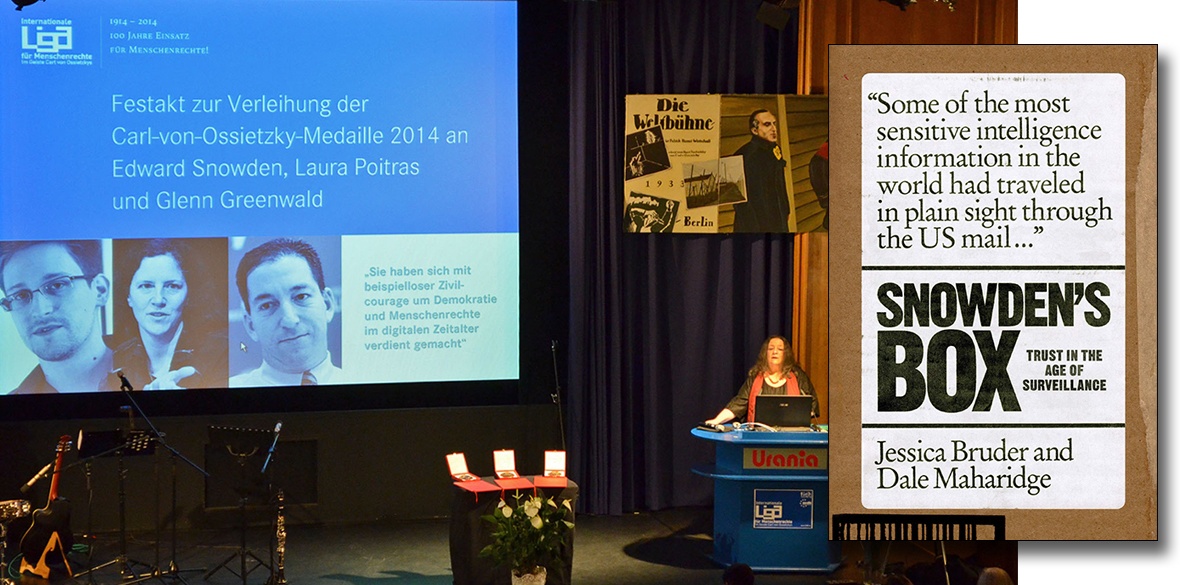This is the last article you can read this month
You can read more article this month
You can read more articles this month
Sorry your limit is up for this month
Reset on:
Please help support the Morning Star by subscribing here
BEFORE Edward Snowden fled to Hong Kong on his way to Russia, he sent a box of highly classified documents by snail mail from Hawaii to a writer he didn’t know in New York.
It made its way, unopened, from person to person until it reached journalists Laura Poitras and Glen Greenwald, who went on to meet Snowden and tell his story of global panoptic surveillance affecting just about everybody online. Poitras won an Oscar for Citizenfour, Greenwald a Pulitzer for No Place to Hide.
Snowden’s Box: Trust in the Age of Surveillance by Jessica Bruder and Dale Maharidge is, as the authors emphasise, a story of trust in an age of paranoia and suspicion. Their aim is to explain how the world has changed since 9/11, leading to a pervasive sense of privacy’s end.
The first half of the book retells the now-familiar story of how and why Snowden stole highly classified documents from NSA contractor Booz Allen Hamilton. In an interview shortly after he outs himself on TV, Snowden tells us that the surveillance state he’s seen first-hand represents “an existential threat to democracy... I don’t want to live in a world where there’s no privacy and therefore no room for intellectual exploration and creativity.”
Snowden had wanted to give his revelations to the New York Times (NYT) but was seriously bummed out when they quashed an October 2004 article by James Risen and Eric Lichtblau that exposed Stellar Wind, the government’s illegal dragnet of American electronic communications.
Approaching the New York Times was thus out of the question, Bruder writes, because Snowden didn’t have confidence that the newspaper “would have the guts to break the story.”
Later in Snowden’s Box, we learn how Poitras and Greenwald were invited by eBay billionaire Pierre Omidyar to start up The Intercept, a new non-profit “alternative” publication. It poached some of the best journalistic talent from NYT, WaPo and elsewhere and seemed, at first, like the Travelling Wilburys of journalism.
Poitras and Greenwald ended up at The Intercept, the property of Omidyar’s First Look Media, and there was trouble from the start. The Terms of Service (TOS) made it clear that readers could be expected to have their presence at the site logged and their comments scanned by Google Adsense and Amazon’s algorithms.
In short, readers could be expected to be surveilled by companies known to work with the intelligence community.
Poitras was discouraged from writing anything based on the Snowden archive. “Notes we took at the archive would be confiscated for review — and possible redaction — by the Intercept,” she wrote, adding: “I laughed. The experience felt like something out of Kafka.” The Intercept has since stopped writing altogether about the Snowden archive.
Poitras, we learn, was also stiffed by The Intercept in her compensation package. “Her compensation was far below that of her male colleagues Greenwald and (Jeremy) Scahill,” Bruder reveals, a disparity amounting “in the hundreds of thousands of dollars.” Poitras and Greenwald have since left the publication.
Toward the end of the book, Bruder and Maharidge revisit the leitmotif that runs through their work. “Trust is the basis of all co-operative action in a free society,” they write. “ It’s the feeling of fellowship that allows people to take risks and grow. It’s also the underpinning of democracy. And it’s fragile, easy to undermine.” Quite.
An appendix offers a “toolbox” of things journalists and readers can do to protect their privacy and the documents of their whistleblowing sources.
Published by Verso, £19.99.
JOHN HAWKINS












